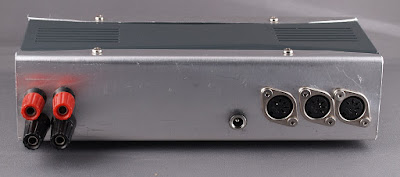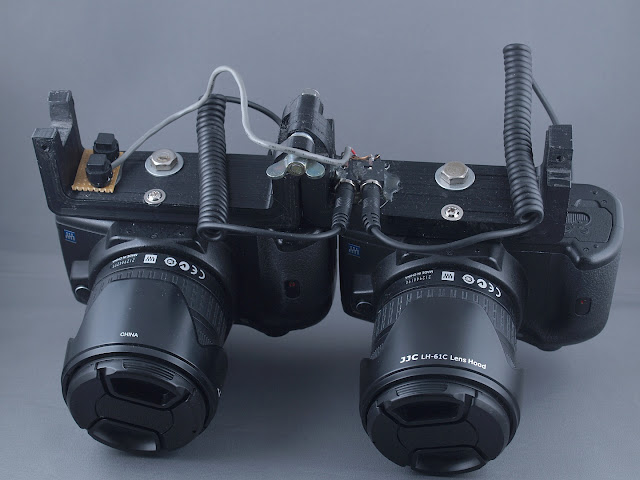For this project, I did something I've never done before - I planned a stripboard layout in advance. Normally when I build things on stripboard the circuit is so simple I can just make it up as I go along, but this one is a bit too complex for that. In fact, given the time I spent plannning this layout, I could as easily have done a proper PCB & etched it. Oh well, it seemed like a good idea at the time. It works well enough too. Without further ado, here's the stripboard layout for the preamplifier, as seen from above the component side.

It's intended to be put into its box 'upside down', hence the unconventional layout of the controls - these will be in the reverse order in the finished item.
Also a first for me is the use of electronic analogue switches for input selection - I've had some 4051 8-way multiplexers for a while and, now that I come to use them, I find that TI have stopped making them. I've used only four inputs (that's plenty for a little amp like this) and, for simplicity have used inputs 0,1,2 and 4 that way I only need to worry about one control line for each input. Had I chosen to use input 3, I'd need to keep S1 and S2 high without allowing 'false highs' when inputs 1 or 2 are selected. That would have involved extra diodes. Incidentally, I've omitted from the drawing the (very much needed) pull-down resistors for S1, S2 & S3 and the link wires to connect those pins to the corresponding ones on the second chip. The resistors were mounted vertically with the ground connection at the top so that the leads from the 2nd and 3rd resistors could be soldered to the lead from the first. I wasn't sure how to convey that in the diagram. The link wires were soldered on underneath to save space. Likewise, the chips' power supply decoupling capacitors were soldered underneath as I've always found that much easier than trying to connect a capacitor from one corner of a chip to the opposite corner with stripboard.
So what was the big idea with this thing?
My old Creek 4040 amp, which was doing sterling service providing sound in my spare room/workshop, along with my turntable, is now at my mum's so she can play records on something vaguely decent rather than a shabby old plastic thing. I needed to replace it. Whilst shopping for sound effect generators for someone else's project, I found this 20W class D power amplifier board:
https://www.adafruit.com/product/1752
It turned out to sound pretty decent, certainly better than I'd expected. So I thought I'd just bolt it onto a preamp, stuff it in a box and off we go. This was going to be a quick & simple project, so I had the notion of using up some stripboard for the pre-amp. Turned out to be a bit less simple than that, especially
planning the stripboard layout, then getting all the track breaks in the right place and wiring up the links.
The Preamp circuit
The power amp runs on a 12V single-rail supply, so it seemed obvious that the preamp should also. This presents the small problem of biasing the inputs so that they never go below the negative rail voltage. This is essential not just for the preamp circuit itself but also the analogue switches - they're not very good at conducting signals that go outside the scope of their supply rails either. The solution is shown below in the section of circuit on the left, which uses an op-amp to produce a virtual ground at half the supply voltage. All the inputs & outputs are referenced to this, rather than to a supply rail. Any currents which find their way to the virtual ground can be drained away by the op-amp rather than shifting the voltage at the virtual ground. A TL072 isn't really the best choice for this, NE5532 would be better as it can source or sink more current. It's plenty good enough for this though, especially since all the other op-amps are used in the inverting configuration which doesn't source or sink any currents to the ground unlike the non-inverting configuration.

The tone controls are the Baxandall single-capacitor type, and the circuit shown here is lifted straight from Douglas Self's book 'Small Signal Audio Design'. It's a bit dramatic for my taste, offering about 16dB of cut or boost at the extremes & I'll probably tame it by adding some more resistors at the ends of both pots and maybe changing the capacitors.
Here's the assembled circuit mounted on the amp front panel. Input selector switch is on the left, 3.5mm jack on the panel is connected to input 4.
The back panel, with speaker sockets, power & audio inputs plus the power amplifier module
The Box, and the Finished Article
I found this old KVM switch in a skip, It seemed about the right size for this project.
The front and rear panels needed replacements, with all those big holes in the wrong places and all.
Here's the back panel. Speaker outputs on the left, power jack in the middle and the first 3 inputs on the right. Yes, they're DIN plugs. I like DIN plugs. They're like professional audio connectors, only smaller.
Here's the front panel. One day I might paint & label it. Might also get some more consistently-sized knobs. From L to R, input selector, volume, balance, treble, bass. 3.5mm jack is the fourth input, not a headphone socket
You know what, though, I reckon there's enough space in there for an RIAA preamp too. Maybe a headphone amp as well.
So What Does it Sound Like?
Not too bad at all, really. No nasty noises, no 50Hz humming or buzzing, and not much in the way of clicks or thumps, except when switching off, but even that's pretty subdued. It does need a good power supply though, the first one I tried produced some horrible high-frequency squealing, not very loud but annoying. As I mentioned earlier, the tone controls are a bit too dramatic for my taste, but they work as expected.
One very big caveat though - some sources need to have the ground AC coupled as well as the signals, unless it's being run from a battery. The negative rail of most mains power supplies is connected to the mains earth, and so is the signal ground of many pieces of mains-powered audio equipment. This will cause problems as the op-amp is trying to maintain the signal ground about 6V above that. My solution was to modify a signal lead to AC couple both channels and ground to use with such equipment. I could circumvent this by using the spare poles on my input selector switch to switch the ground to the appropriate input & AC couple that to the preamp's virtual ground, but then I'd also have to add coupling capacitors to all the inputs, otherwise they could stray outside the supply rails. There might also be thumps & pops when switching inputs. There's no problem with battery powered sources and 'm only using one mains-powered source so I'll leave it as it is for now.
 The structural mods I described in the last post do indeed help with rigidity, but there's still a bit of an elephant in the room in the form of the lower frame side rails. In order for the vertical frame to oscillate left to right, the lower frame rails have to twist where the vertical frame joins to it. As supplied, those lower frame rails are not very good at resisting torsion - they're just a horizontal 40 x 20mm extrusion hanging in mid air at the point where the vertical frame joins them. You can see this in the picture, along with my solution. I found a bit of 45x45 extrusion in a skip which turned out to be long enough to span the full width of the printer with a bit of overhang. I used the horizontal beam from the top of the vertical frame to mark out four bolt holes that line up with the central tubes of the vertical beams and some longer bolts (M5x60) to to attach it simultaneously to the lower frame and the vertical beams. This makes a huge difference to the rigidity of the vertical frame. I might have a go at making a video to show just how big an improvement this gives.
The structural mods I described in the last post do indeed help with rigidity, but there's still a bit of an elephant in the room in the form of the lower frame side rails. In order for the vertical frame to oscillate left to right, the lower frame rails have to twist where the vertical frame joins to it. As supplied, those lower frame rails are not very good at resisting torsion - they're just a horizontal 40 x 20mm extrusion hanging in mid air at the point where the vertical frame joins them. You can see this in the picture, along with my solution. I found a bit of 45x45 extrusion in a skip which turned out to be long enough to span the full width of the printer with a bit of overhang. I used the horizontal beam from the top of the vertical frame to mark out four bolt holes that line up with the central tubes of the vertical beams and some longer bolts (M5x60) to to attach it simultaneously to the lower frame and the vertical beams. This makes a huge difference to the rigidity of the vertical frame. I might have a go at making a video to show just how big an improvement this gives.












































